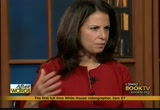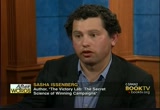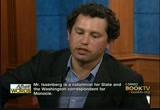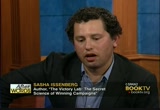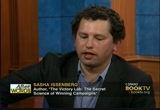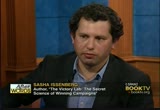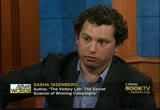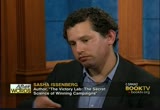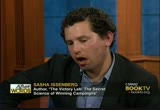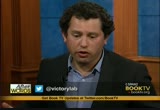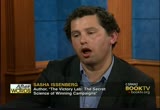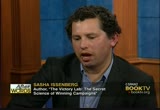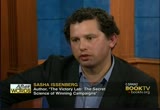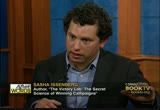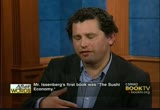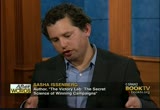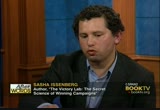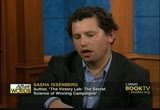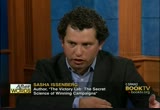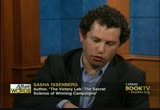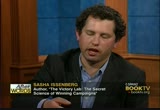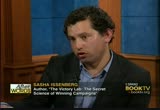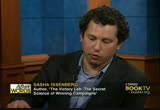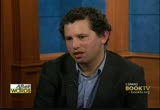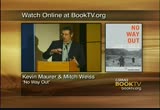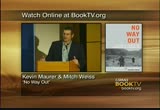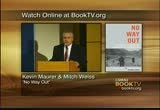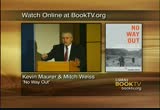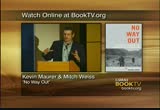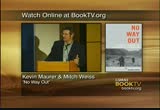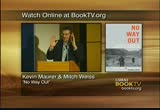tv Book TV After Words CSPAN October 1, 2012 12:00am-1:00am EDT
12:00 am
continuity wising here's the problem we are going to have four years or if we want more than a billion dollars to answer it. that culture and the institution building that is taking place around the obama campaign helps give the democrats a major advantage and in the 08 campaign, as i write about in the book come this is an exceptional experience, it is partly because of the long prairie. he is in the stuff that so many of the people on the campaign came into contact with pretty sophisticated tools and in politics, and a lot of those states who are a field director and using the slowly advanced data in 2008 went out and went to state parties or labor unions or institutions on the left and there's a sort of pollination that is taking place that i think a little more active on the democratic side right now than on the republican side. ..
12:01 am
and the ore opponents by using data. but there are scrambling to sort of build anything approaching the scaling of the obama campaign and anything approaching l am ambition of the obama campaign. types you can solve in six months are going to be smaller than what you can solve in four years. >> host: doipg you the
12:02 am
campaign is going to rely more on messaging or on the targeting techniques. what is is the mix? did does message still matter. is it really if you can fine tune it and target it better. that's going to be the difference. how do you put that all together? >> the message still matters. one of the things, the whole narrative, you know, in the bulk of my book takes ten to fifteen years, has taken place in an era of a real partisan polarization. one of the 2000 ends up being a formative moment, i think in terms of innovation and politics for two ones. obviously it's a close election. and so campaigns that might have once said, wow, 1%, 2% more of the vote if i you the technique. one or two% and i can use that. there it starting to be a real focus on techniques that can provide very small but measurable boosts.
12:03 am
that's one thing that happened after twowp. we realize we are moving to israeli deadlocked. it was the chief pollster and strategies. started writing a memo while the supreme court was still taking up the case, and, you know, the polling data from, you know, from 1984 something like 25% of american were party switchers moved between the two parties. by tbown it was 7%. we are in that era now. a small pert age is the persuadable. most voters are predickble. you know, they like to sell pollsters are undecided in the campaign. there are far fewer voters who are actively moving between the two parties as there were previously. and when you get in to that
12:04 am
environment, it's a lot easier for campaigns to visualize where they can get benefits by focusing on turnout or registration for the porters as opposed to merely trying to persuade the small. i don't know if it's 6, 8, 9%. obviously campaigns are going to focus on them. we we have a far better science now in understanding what mate voted people to vote and a lot of it informed by behavioral psychological research. the science persuasion still pretty vague, and so i do think that there's been a sort of reinvesting in a lot of mobilization techniques in part because we have learned in the last decade how they work. you have the two separate thing. you know when you get to somebody what you can do by
12:05 am
increase their likelihood of voting by 2% with i have better techniques to figure out who you talk to about what. i don't think about it necessarily as message or targets. good campaigns do targeting and analysis on the front thanked allows them to understand in a far more precise clean way for who are the turnout targets who they don't need to talk to until it's time to push them to vote and the persuasion targets. if you're narrowing the people you can presuede you can make the message sharper. you focus the groups in polling and exoormt tal testing to get more closely to the question whether it's 7%, if you're talking 7% who are persuadable and not trying to come up with messages that speak to a far bride and trying to persuade them all at once. >> i know in the book you
12:06 am
mention different techniques that ares you'd people to vote. i know in the country it's a low level many times with the sort of participation. could you explain some of these techniques that are used two actually get people voted. >> guest: yeah. the best demonstrated tool for getting people to turn out and vote was measured in experiment michigan in 2006 before the republican primary. and this consult assistant and file vender named mark who had the practice of threatening to expose people. they didn't vote. and he organized the experiment with the two political scientist at yale don green and alan who have been pioneers in using basically the same method that people use for drug trials to apply to campaign techniques. the ran donl control trials. instead of distributing the placebo. you can send mail and see who
12:07 am
voted and who department. you the first time you are able to disentangle cause and neivet political pool tools. in michigan they found that remarkably effective was sending voters a copy a letter before the election that said deer nancy, as you may know, your history as a voter is public available document on file with the board of elections, as you may know there's an election comet up in a few weeks. after the election, we will send you and your neighbors a copy of your vote history. it had a line with the recipient vote history like the last six election. you voted in the senate primary or the school board election. you had a bunch of people selected with addresses and after the election it will send everybody on the list one of
12:08 am
these. you got death threats when it went out. tons of other scolding who people thought it was bullying. it turned out to be remarkably effective is the social call social pressure. the expectations that people would have friends or neighbors whether or not they participate. not who they voted for. this paper was publied and revolutionary because it basically was like ten times more seven times more effective than anything ever been used before. no campaigns, parties, constitutions wanted to put their name on anything like this it. really did seem like some form of blackmail and there was a fear of backlash. but over the next four or five years, a lot of institutions many of them on the left academics working with union, the dnc candidates, try to
12:09 am
exexperiment with how to solven the language. and now with sort of wide spread practice of sending a letter out that they called thank you treatment, and it said something like thank you, publicly the records show you voted in the last election. i want to thank you for being a voter. there's another election coming up. i'm hoping after wards i can thank you you again. it -- people don't use it over and over again. most where near as effective as the threat to expose people with the behavioral psychologist who work in the space -- gets same mechanism which is that i think that voters have become so conditioned to have a secret ballot, many of them don't know that their vote history is publicly available. every campaign knows how often you vote in elections. and don't realize that they can -- they're sort of visible in a sense. and that they can be monitored.
12:10 am
and this idea of hintinged at people that there is some sort of surveillance that can take place and people will judge you. you know, it's clear people want to be vote -- people want to be seen as voters. it takes voting to be able to see them as voters. experiment show time and again they'll dough it. >> host: interesting. does anybody use that in the primary. people aren't showing up to vote. is it a technique. >> guest: certainly around the country people have. i don't think in the republican primary i heard anybody using that. it's being so wide spread in certain areas people afraid it lost it's potent sei. that there's no element of surprise for vote fors they gate piece of nail kind of nudges them that way and, you know, once the -- once voters got the idea that they are being surveilled there's only so much
12:11 am
left you can get in conditioning the behavior next time. there's a sort of constant trend. one of the things that is taking place and i wrote about in the book. behavioral psychology informed so many aspects of human life in the last generation or so. economics has been transformed by behavioral. politics, political science has been late to accept them and once political scientists sort of rediscover the use of experiment to actually go out in the real world and test techniques and campaigns on voters within they sort of naturally went to basically went to behavioral science textbook and said what are the thicks people are using to motivate individuals to recycle or buy certain products or change their investing habit and can we chance them to voting or registering. and so there is still is, i think a lot of stuff that has
12:12 am
been demonstrated in realms other than politics that is having attar soft psychology mechanism that people who work in politics thinks it can be translated in to political behavior. almost all in the range of motivation not persuasion. i think there's going to be more that comes out of the role that changes the texture of communication we have. >> host: do you think most of it is a weighting people toward voting and figuring out the signs between the persuasion. >> guest: yeah part of the way they design the experiment is whether or not somebody voted. grout board of election a month after the election. they updated the voter file. it's yes or no they voted. persuasion on polling before or after to see if they changed their mind, so you to rely on them being honest or consistent at least in the sort of the
12:13 am
self-proreporting of their choices and -- and the over reason a lot of the people have been started doing this work in academia were using basically not profit dollars through their institutions and they couldn't do partisan work. it made it difficult to do persuasion in the complain. if you were doing noncandidate specific you can spend university dollars on research budget on. there's a big body of work on the gobt and a lot formed by the behavioral psychology. there's far less knew science on persuasion. one of the thing i've written about this year is how the obamacare are trying to adopt the measures the effect of the mail and the online ads and tv ads. it's more complicated and expensive. it's a way of trying to break out relying so solely on polls and focus groups that imagine in
12:14 am
a artificial setting that would change their mind and introduce them to information in the real world they don't believe they are exaiskly being examined and if it changes their mind. and that's one of the next ways, i think is using the experimental techniques to see what does move voters and get out of the sort of art official setting focus groups alone. >> host: on the note with the obama campaign since they had times four years ago to test it and four years later, is there any innovative or techniques they are using now anymore that you can -- >> guest: yeah. the experiment informed programs are really the thing. and they have been using in small narrow ways by some institutions, the cio, emily's list over the years the obama
12:15 am
campaign has this year is a major advance. part of the problem with the way that people have tested messages historically is that you either have a poll that asking somebody who they support, and it they wills them a bunch of information. you see if moves or you ask somebody directly. if i told you romney hadn't paid taxes for x number of years make it more or less likely to vote for them. some people fell you would they move. people telling you they would move is a pretty sort of con ject yiewrl thing. i wouldn't cognitively trust anybody that would do under the hypothetical scenario. they may or may not already know. that's part of the problem with the polls they ask people if you knew of a piece of information you may or may not already know. or in focus groups you bring
12:16 am
somebody in and so you a dozen people and show them an ad and you ask them again did everybody change their mind. you're purchasing somebody to change their mind and they're being forced to watch an ad they might tune out. using the experimental things that the obama campaign has. they randomly assign mail ron comely to a -- randomly assign tv ads to certain markets and then because they're polling across those markets, they can see who moved, based on message or type of ad or mail this they have the data, you know, thousand of individual data points on each volter. they can look at the attribute of the people who did move. not just the people who said they would move. you start to statistically model the traits of somebody who moves when they see an ad about mitt romney's taxes, instead of just
12:17 am
polling people and looking a the type of people who said they would move. and then so they have got tb to do a cycle of a few weeks to develop tests randomly assign and distribute the ads and measure the movement. and so at the end of, you realize, okay the people who are moving on the tax message, let's say with, you know, conservative retirees okay now let's go send these ads to conservative retirees, and that's a radical new way of both transferring some of these experimental techniques to measure persuasion, but also getting rid of all the sort of con ject really a hypothetical message testing that has been used in polls and focus groups and getting to something to get the behavior of change your mind. >> host: interesting. how expensive is this? how much money do the campaigns have to raise to really do this
12:18 am
at leaflet you're talking about? >> guest: it's expensive. but i think that campaigns and invest intelligently in it will tell you it should pay for itself. and so, you know, one of the benefits of sort of microtargetting, is that it helps you in the early process of sorting through the elected rate. and so if you can cut ten or 20% out of your persuasion university because you're smarter about you should be talking to. it's 20% of yourless budget or the phone budget. if it helps you buy your tv smarter then, you can save money or redirect your resources. there are campaigns that sort of, you know, buy microtargets as something they add on the mail budget. in that case, it's an expense and it may help them win both or not. campaigns is sort of bill the
12:19 am
certain type of an lettic and targeting to the strategic projections should become smarter about how they spend all thundershower other money. they're not sending persuasions messages to people who vote for them or people who will never vote for them. they are sending the right messages to people. we're not going send every woman a message about the abortion. we will send the 18% of women we model as actually move able on abortion messages and figure out what the 82% of them rest of them get talked about about. i think that's, you know, that it's a, you know, it's a expensive collect d.a. and and analyze. it's expensive as the obama campaign has done to, you know, a in-house can that and analytic shop many of whom who are working in private sector jobs that paid good money before. i think the campaign manager
12:20 am
will tell you that will allow them to be smart are and get smarter. along the campaign. the more refined your models and prediction and projections are and that in the tend pays for itself. >> host: wing we're going to take a break now and we'll be right back. an the go? afterwords is available via pod cast through itunes. visit booktv.org and select the pod cast. select which one and listen to it while you travel. >> host: so i think microtargetting, i mean, everybody heard the phrase, can you explain for everybody what is microtargetting exactly and how is it used in the campaigns? >> guest: sure. the biggest, you know, two types of campaigns that campaigns have. there are mass media with the
12:21 am
campaign doing free targets. trying to get stories in newspaper an paid media has been tv ad and radio ads. those are very targeted. you can. be in a certain market and times of day. you can't specify more than that. is the other type is voter characteristic. talking to individual vote piers. you know who you want to talk to. and you can talk about specific messages or target get out the vote reminders to them. here you put together, you know, campaign call a universe of your targets for something. and because proposal registered as specific address and have a phone number, you know who you're talking to and not the household level. it's one of the big changes of any campaign that has been going back 1200 years in the united states is figuring out we're talking to people individually. who are we talking to. and who are we talk to them
12:22 am
about. we used to have little information on each voter. we had the voter role, the name, age, address gender, in some places the race, and then you had some information you could sort of extrapolate from them based on that they live. what the census told you about the tract or area. and what you knew about the precinct. you knew some of the some party registration in stateses that had. not everybody votes exactly, you know, certainly throughout 209th century we had a lot of people voting republicans in certain elections. with looking at precinct. and so campaigns arizona assort of computing power increase through the middle of the 20th century. it's way of dividing the elect rate. it's basic triage that every
12:23 am
campaign wants to do. who are my people that are going to turn out and support me in order to vote for me i'm not going waste a dollar. who are going support my opponent. i don't need to talk to them who is in the middle? figure out what i'm talking to them about. and so precincts officered a very basic way of dividing a state or congressional district. if you are a democrat you would say okay, people in strong democratic precincts i want to turn them all out. turn out people there precin i'll turn people to vote against me the margin is large enough i'll be turning out net put myself. i'll ignore the republican predicts. and get out middle that are 40% or 60%. i'm going to try identify each voter to know who they are going
12:24 am
to vote for and what issues their care about. people set up phone banks. setting up phone banks was an expensive process in the o 50 and '60. interstate call was expensive you had to go to the area and set up room. as soon as you did, somebody would start calling voters off voter rolls with a phone book and say who dow yo plan to vote for. one of the things about the united states people are used to strangers who they are going to vote for. you come up with a list of how individuals plan to vote and often get the information about the issues they care about. and the same thing happen. you send canvasser. you they try to identify voters. and they sort people out. who do i have on my seed, who do i need to keep targeting with mail or persuasion phone calls?
12:25 am
and so this is the campaign have always worked. what changed in the shorting at the end of the last century. we got the other data about people. it was well beyond the census new about the area and the voter registration ronald told -- told you about. it a lot was collected by commercial marketers or specially the credit ratings agencies which had in the interest in accumulating as much as possible information about the dem gracious, the consumer handles, the lifestyles and what happens started in the late 1990 was people in politics discovered they could fuse what they knew about you political i and your predict with the other sources of information and use statistical modeling techniques to basically run algorithm that
12:26 am
could predict how you would answer the question who are you voting for. sop instead of in a given state, having to set a phone banks or send out canvasser to knock on a million doors of people who are in the precincts that are in the middle, you could use the modeling techniques to predict what each of the people would say. and then do you the same thing, which is the people who were, you know, in the milgtd, persuadable. send them mail but know at the individual level, you wouldn't be writing off people base on the the geography or their voter registration. and so this technique really took hold in 2004 and 2002. the bush campaign was the first major campaign to successfully design and implement a system where the type of microtargets in form with the campaign did. what it does is use sort of tons of available individual level information. sort of automate the process of
12:27 am
how somebody is going to vote. you're no longer doing tremendous age by precinct and by individual. you can take two people who live in neighboring pardon pardon me -- apartments and without knock on either doors predict who is likely to be with me or my opponent and still be undecided and come up with a separate treatment for each of them. >> host: the need for traditional con vasser is that sufficed. do we need it as much? >> guest: i think we need it differently. i think campaigns like the obama campaign is smart about that. they do send people tout do ideas and those ideas feed if that their statistical models and in 2008, the obama campaign was basically modeling the elect trait and swing states every week which is to stay they would out tens of thousands pay phone
12:28 am
calls and the volunteers talking to voters. data from commercial venders were feeding in to the alga rhythm. they come up with a prediction how they would vote. whether say that would vote. it allows you to guide canvassers to talk to people about particular issues. and so and so it's not there's less of a need to do all of your identification work individually. it happens h helps to have volunteer activity. one of the shifts that we see on the obama campaign this year, i think they're going to be using their canvassers far more from persuasion work and not just for ideas. and historically campaigns usually thought it as i use my volunteers to use the grunt work asking people who they are going to vote for. if my volunteers knocked on
12:29 am
1,000 doors and 100 people who care about abortion. i'll give the names who does the mail prochiewrs. and now you do a lot of the predicting which hundred people are most likely to be responsive to your message on abortion. and then neighbor use the volunteers like the obama campaign you have a ton of people willing to help, and maybe you send them out to knock on doors or call the 100 people who indicate who care about abortion. one of the things that come out of this is meaningful volunteer person to person communication means something. it has an effect. it has an effect that call centers don't have. you know, that it has a that when callers have what they call chatty calls, which means they don't just go buy script
12:30 am
verbatim, are able to improvise a little bit and sound more natural. people on the other end clearly perceive it back. it makes them more likely to turn tout vote after the conversation. one of the themes, i think, running through the whole book is it's all high-tech modern stuff that is made possible by, you know, massive collections of data that are taking place by advanced techniques, computing power, all things that we didn't have twenty years ago in a form they do now. but there's a rude awakening of the human interpersonal dynamic in politics. i think we have seen over the last decade the number of campaigns, a mixture of the dean campaign in bush campaign in -- and i don't think those things things are conflict. and i think that, you know,
12:31 am
12:32 am
they know more about you, they know about what moves you coming and i think in many ways what we are seeing is sort of the opposite which is they are also seeing the value and can now measure the value of two men traction and so smart campaigns wanted figure out how to allocate those as intelligently as the elkader of their tv buys. >> host: so personals touch still matters. >> guest: they're maybe some of knowledge about a personal touch is better. but there is a residence to trust their volunteers to talk to people so i think there was a sort of -- there's still centralizing the obama campaign as centralized as any of them but right now they are able to measure the certain types of volunteer interactions and campaigns are willing to see a little bit of control and not assume the message is always
12:33 am
best processed and carried through the mail that's designed in the headquarters but that there is a benefit to having people talking to people especially if you have done the difficult invisible work when and what and the campaigns are still waiting in. i look at the obama campaign inouye and i think that they were quite good at sort of molding the left brain and right brain approach to the modern campaigns and the will to spend lots of money and data and field staff and i think looking through that is one of the things that this grant be the most important figuring out how the campaigns, it's certainly true online how they can balance their need and desire for control to control their message, centralize their tactics and strategy but also maximize the energy and talent
12:34 am
and value of their supporters doing things on their own to other voters. >> host: i would imagine all the stuff that you're talking about is meant to be focused on the states. can you just remind us what those states are. most of the techniques are going to be termed. >> guest: the states may move from week to week. one thing that is important to realize it is not all swing states are equal or alike and i think we tend to think of them interchangeably and see a set of polling has a bunch of states there but between 46 to 49% and the campaigns are on the air so they are swing states and they are all in the same category.
12:35 am
campaigns are deciding where they compete and how they compete and this is the sort of central strategic document of the campaign and what i learned about the 2008 campaign david clough would call this his bible that targeting is put together that had the vocals and everyone in the state. for each state they would have the total they needed to win and they predicted 53%, that is a little bit of a buffer to sort of guarantee the margin of victory. but the question on the path how you get to that number in any given state is a different and in some states, it was all mobilization. in some states it was all in pennsylvania is a pretty good example of that. the democrats mobilize votes that they have come supporters
12:36 am
they have in the state. there's a path to victory basically through mobilization. there are states that rely on persuasion. ohio is a pretty good example of that and then you have states that rely on registration. so there are three numbers for each and the number precision target's registration target's and they would be radically different. they knew they had to register voters to even be in play. what that does is strategically you are doing different things and many different parts of the state it may look as though the campaign is competing but within the campaign they are thinking really differently about where they're putting their tv ads on and where the candidate goes. one of the things i write about in the obama campaign there was
12:37 am
one little example john legend did a small concert i don't remember what the town was but it's not a large city. he was in columbus and cleveland it was a county seat and the reason he went there is they had seen the registration numbers for lagging in this particular area and to reach the registration goals which the head disaggregate it from the state down to this particular piece of turf they had him do a concert oriented registration the city hall or people could go and register and it wasn't that they send john legend to turn people out, and that's happening in broadway everywhere and so
12:38 am
there will be states we're talking about at the end of october where they are competing but each will be competing differently and each of them based on their vocals which are coming out of those microtargeting prevention's which are taking every name of every individual person they think is already supporting them and considering the target taking every name of people they think of as purse readable and that is informing the tv buys, but the candidate goes, the male and everything. >> host: with everything you know, where do you think the key state -- will there be one that it comes down to or you are interested in the cycle that intrigues you? >> guest: virginia and north carolina are intriguing to me just because they are new states in the presidential politics and so, i think it's interesting to
12:39 am
see how the campaigns that don't necessarily have a sort of reflective set of tactics for competing and then adjust where the parties are not equally as published. the one thing generally after spending a year or so talking on the campaigns and they have the most granular familiarity with not just the data and the statistical models about politics but also the real empirical cause and effect is that i put less and less faith in people who are confident about things they know where their predictions for some of the people we spoke about are the ones the most willing to siggerud very big things. i don't know about that. i think there's a lot in
12:40 am
campaigns we've learned the last ten or 15 years and in politics have learned what works and what doesn't but it's also made those people are more aware of the limitations of knowledge and the limitations are significant. there is a massive amount about what happens in sidey elections -- inside elections and it is more or less not knowable and anyone that speaks with too much confidence about how things are and how they will be resent to be trusted. >> host: what you think about -- we have heard a lot about other tactics, but tv advertising. what does that whole world looked like as we see more of the internet and tv coming together being one in the same. can you paint a picture? >> guest: one is the basic question of knowing who you are actually showing your add to when you buy an add-on broadcast
12:41 am
cable. we are getting better at that. one thing that is interesting. i write about rick perry's 2006 gubernatorial election and was the third campaign to do large-scale randomized experiments and one of the experiments they did is randomly assigned his tv ads for three weeks across the state and one of the professors or the four academics were called the eggheads by his adviser and one of them is a professor university of maryland realized we talked about media markets but do we really knows the six media market is just a signal for the tv and in the one that is driven a knife and tried to listen to a ballgame and knows the signal goes in and out or you can hear falloff in the city that you are not in, you hear a station, you realize that almost
12:42 am
certainly the bound of a media market are not those sort of neat circles around the city that we are used to dealing with. so, the key elena kagan in the partnering with a graduate student in the service academy and the naval academy and they started in engineering technique and it turned out that the edges of the media market looked nothing like what we generally think of as the media market and how many points did you put into which media markets. it turns out it doesn't look like the people were inside or outside whom you thought were on the other side of the line and it's not consistent. the other thing is the points are a really crude measurement and 100 planes is the average number of times a given person sees your ad. people have -- there have been a few times where nielsens
12:43 am
basically allowed political target is to match individuals, their individual viewing habits to a voter file and model individual things so it turns out that yes it's an average of the average distributes on the crazy code as you think when you think about your friend to the tv viewing habits to the average maybe each person sees it five times or 20 times and a lot of people see it once though very few people see it five times and this is the way they have been bought for a generation now. on the one hand they are becoming a lot smarter at understanding when you buy a point of tv who is actually being exposed to it and they are able to make much smarter and less crude decisions about the way the conventional broadcast dollars go to that. the other thing is few people
12:44 am
watching tv live television period, and the natural substitute for that is web advertising because you can still run video. it is amazingly in valuable medium that can't be replaced just by mail or by phone. voters like to see the people like to lead them and do a lot of things with motion picture and obviously you can run video ads online big challenge and we're seeing the advance every month now is numbing as much about who people are online as we do but who they are off line and still politics takes place off line. people vote at their home address and if you are republican voting in the republican primary the challenge is making sure you know who
12:45 am
those republicans are and which district they lived when they are surfing the web or watching videos on hulu said the challenges that is bringing some level of geographical political targeting two web advertising with very this video or simple banner ads. until this year the internet for communication was used as a fund-raising outlet and most of the reason is the you could measure rather effectively what worked in terms of the fund-raising online. you run the web and you can get a very measured response rate and figure out who's donating and what's not and what they respond to. we are now starting to get enough data to use the persuasion initio tv tools and
12:46 am
that will allow the campaigns to have a better idea of who they should talk to online and on conventional tv. >> we have a couple minutes and want to ask to more questions on privacy. should the voter be concerned that the campaigns are getting more and more data? >> guest: one of the things we have always had with the expectation of privacy and politics than other areas remembering before the internet can along with the given a refund for starting to get a call from dinner to the cutting dinner from someone for your name and party as a trustee for registration and tony may be one of my colleagues called you last week to talk about abortion. i'm calling to remind you talked to my colleague about abortion and he'll send a van to your house next week to draw you to the polls they are annoying but
12:47 am
no one really founded that invasive so there during of new methods isn't a lot beyond that. your voter is public and campaigns collect that information and one thing written of this year is partially because campaigns are really afraid of the backlash of getting lumped in with the aggressive things the markets are doing but bending over backwards prospectus surgeon types of privacy restrictions on the cookies online at there are not required to beyond the legal standard, so this, campaigns know more about you but in many ways campion's use it to talk to you but the things they want to talk to you about and they have
12:48 am
no interest in doing anything other than catering to your individual needs or interests. >> host: we have a minute or two before we close. what would you want to say to people listening and learning about this. we are weeks away from this election. what advice can you give to the voter in terms of what they should be paying attention to in the swing states? >> guest: one of the things that comes out of this is the things you don't think it necessarily as the high science of campaigns for the places where the biggest research, canvassing scripps, a kid not senator asks you a few questions amazingly that has been replaced your the greatest energies and insights from the beatles ecologies have been brought to
12:49 am
bear some liberalism really closely to what people must you on the phone, what they ask you at the door, why your mail looks the way it does because my guess is that a lot of this informed by an amount of sophistication about the human mind would shock you. >> host: thanks so much. the secret science of winning campaigns this is just so timely and provocative and it seems like it's laying the groundwork for things to come so just want to say thank you are doing this. are you going to be spending a lot of time on the road yourself and looking at more campaigns in this period of time? >> guest: i've been reporting on slate for this same sort of thing so especially writing about d.o.t. and the nuts and bolts this is the fun time so i will be on the road until the
12:50 am
12:51 am
flying helicopters is hard. the only way in is by foot or helicopter, so trying to get there initially the plan of initiative was tough. they were going to go after the high-value targets. he was a hagee commander. they had in the season of al qaeda, some sort of truth with the taliban, but they are nasty characters. foreign fighters from chechnya in the are not really there to fight against to fight from afghanistan or for their version cure mercenaries and what they're doing in the area is recruiting while pressing people into fighting for the hague he was rumored to have service to
12:52 am
air missiles he was also credited with than bush in the cornball volley that had caught the attention of some of the commanders said they decided they had to go off the volley and take care of this network because he was able to export a lot of the violence from the stevan to the idea was to get him and take care of the safe-haven. what they ran into this not only the excess in geography because a was a hard place to get to the roles of fighting the restrictions placed. you've seen these night raids that are highly regulated, who controls the battle space of the regulated and it takes a long time to get emission plan and one of the things they were running into is how to get their, with helicopters could to and where they would be allowed
12:53 am
to go and what they came back with is the idea they were going to fly to the valley, land in the valley, unmolded their soldiers and the initially wanted to fly to the top of the valley to the village and then they broke down but because of restrictions and with the pilots were comfortable doing the in the that having to settle for this mission was to lay in the valley and unload the ships which anyone who earns any kind of basic introductory is never a good idea. you never want to do it. it's infantry won a one. with the commanders have to pretty much reconcile was where they were going to place the risk was it risky to fly the helicopter to the phill pledge your to put them in the ground to get the the hill.
12:54 am
this is where it starts. they get up in the morning and they know they have to do this mission in the mountains of afghanistan. the weather has already pushed on for twice and they all have this feeling i don't know if this is a good lady had that feeling is one of the things that propels this book and us because it is very rare that you get soldiers that have universal feelings like that and they stand up and say not only but we took the chain and said look we don't really what to do this mission and that starts them on the path that gets them to an ambush. >> that is critical of what he mentioned in the book. you don't usually get soldiers in the plans and the captain
12:55 am
basically [inaudible] with you try the element of surprise. he took his concerns to his commanders and his commanders said was important to do this mission he helped finance the subornation and when they later found out some of them had shown up in arizona so he would finance his whole campaign and the team knew that this plan was flawed but even though he knew this, he knew there was
12:56 am
incredible danger and they would have to climb to the top of the mountain to get to the compound. [inaudible] the and the fighting for ten years they still wind to carry out this mission and i think you can describe what happened when they landed. >> a takeoff from a base on the border and fly into this valley and there is some concern with the planning and the weather there is a certain window that they had they could get in and out so the have to work quickly as wall but if you can imagine
12:57 am
the plan is to land but there was so much level and i use and other ground was on the even some of them couldn't even land so they were jumping 10 feet out of the back of the helicopters and landing on these fields and some of them landed in this river in the middle of the landing zone. degette past without any injuries. it's the size of a basketball court so imagine that. they looked up and the mountains surrounding orloff higher than they ever imagined. they were looking at satellite images. just being surrounded by all sides busheir eclipse. the consolidated and start walking towards this village and when we say village ensure i don't know what you think in
12:58 am
your heads but depending where you are in the country sometimes their mud huts but this village was literally cut into the walls almost endless stone houses like castles on top of each other the wood line all the way up and they were surrounded almost 360 with these stone houses and as we are walking that it takes them awhile to get to the path and it cuts back and forth in a zigzag. you know number-one there's only one way up and he's in the cul-de-sac of a valley no and they know because the helicopters. if they hear helicopters in the valley it's not them, it's their
12:59 am
bad guys. they're walking up and all of a sudden they see three guys running on the top of the valley and one of them has a gun. >> you can watch this and other programs online at booktv.org. now joining on booktv is author dalia who has several books coming out in the summer of 2012 plus this broadside which is a small book put out to buy obama's policies enter america. first what is the broad site? what is this to represent? >> it is a short easy to read a book for people who don't want to read a whole book and many books on many different subjects ranging from taxes by my friend
125 Views
IN COLLECTIONS
CSPAN2 Television Archive
Television Archive  Television Archive News Search Service
Television Archive News Search Service 
Uploaded by TV Archive on

 Live Music Archive
Live Music Archive Librivox Free Audio
Librivox Free Audio Metropolitan Museum
Metropolitan Museum Cleveland Museum of Art
Cleveland Museum of Art Internet Arcade
Internet Arcade Console Living Room
Console Living Room Books to Borrow
Books to Borrow Open Library
Open Library TV News
TV News Understanding 9/11
Understanding 9/11
